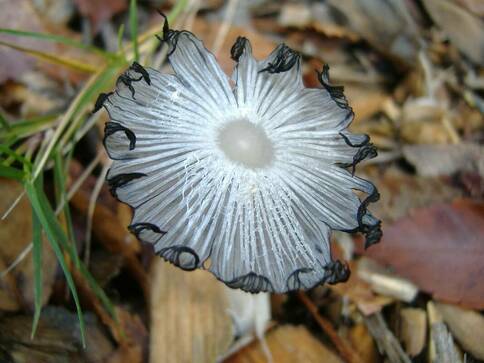|
Video link: https://www.youtube.com/watch?v=TrKJAojmB1Y Meet the genus Pilobolus! The Cannon Fungi
These fungi are in the phylum Zygomycota. The Zygomycota make up ~1% of fungi.Their life cycle begins as a small dark colored object which contains spores (seen here on the top of each of these stalks), usually found on plant matter. The plant matter is then consumed by an herbivore (plant eater). The herbivore passes the spores through its digestive system until the spores are embedded in dung when excreted from the animal. These spores then germinate and grow throughout the dung, eventually forming a sporangium (dark colored bit) on top of a little bubble looking structure on a long stem (seen in video). Pressure builds... And builds.... And builds until.... BOOM! Isn't that amazing?! (I'm assuming you just watched the video. If you couldn't see the video, imagine a dark spot rocketing off of the club like stem) It has been estimated that an equivalent would be launching a human at a hundred times the speed of sound! The fungus must do this so that the sporangium will get far enough away that it might hit a plant that an animal might eat. Animals typically don't like to eat near their dung!! So this sporangium gets blasted high into the air (up to 2 meters!) and perhaps lands on a nearby plant, where it gets eaten once again and the cycle continues! Fungi are Awesome. Video link: https://www.youtube.com/watch?v=EGlaQhDi5ts Yesterday while walking past a landscaped area, a series of what looked initially like overturned acorn tops caught my eye. Upon closer investigation, it turned out to be a population of Bird's Nest Fungi!
Check out this high speed video of a water drop hitting Bird's Nest Fungi! Bird's Nest Fungi make up the family of Nidulariaceae and are Basidiomycetes! Once recognized, it quickly becomes obvious why they are called "bird's nest fungi." Notice the small things within each "nest" that look like eggs! Those are called peridioles, and they are just little structures that contain spores. When a rain drop falls in the cup, the peridioles get ejected and break down, releasing the spores into the environment! It's quite remarkable. My wife and I recently returned from our anniversary trip to Newport, OR. While there I got to see numerous mushrooms species which was a nice escape from the dry conditions of Southern Oregon where we live. I wanted to spend this post talking about one of the species I found!
Meet Coprinopsis lagopus, one of the Ink Caps! It's a saprohytic fungus which can commonly be found on wood chips, dung, wet ground, and rotten organic matter. They grow and decompose quickly and are quite fragile. It has been found to produce some antibiotics, although status of its edibility is different depending on what source you choose to refer. Most agree that it is too small and flimsy to be worthwhile for sustenance, anyway. Ink caps get their name from the fact that they deliquesce, or liquify while digesting themselves, in order to help release their spores. The gills and tissue around the gills breaks down creating an inky appearance at the margins of the cap. The spores of ink caps are typically very dark colored which facilitates this visual effect! These Ink Caps sometimes contain the chemical coprine, which when ingested with alcohol can be poisonous, but when consumed in the absence of alcohol seems to have little to no affect! This species is a great example of how modern molecular and morphological analyses are changing the categorization of many fungi. At one time, this fungus was known as Coprinus lagopus, but it turns out that many fungi that were lumped into the Coprinus genus are actually more closely related to the genera Psathyrella, Agaricus, and Lepiota. The only Coprinus that remains is the edible Shaggy Mane mushrooms, Coprinus comatus. So now what once was the diverse Coprinus genus has been divided into the genera Coprinus, Coprinella, and Coprinopsis. This is a common trend in modern mycology as little attention has been given to many fungi. It is certain that further divisions in fungal taxonomies will continue as the field of mycology continues to grow and we learn about all the treasures these toadstools hold! |
is presented by NATURAL LEARNING ENTERPRISES.
Learn more about Natural Learning Enterprise's science education initiatives and what you can do to support scientific literacy at NaturalLearningEnterprises.com
Copyright © 2013 - 2023
Toadstool's Treasures is a registered trademark by Natural Learning Enterprises, LLC. All Rights Reserved.
Web illustrations by Jason Wilson unless otherwise indicated.
Book illustrations by Hannah Nico Weaver unless otherwise indicated.
Toadstool's Treasures is a registered trademark by Natural Learning Enterprises, LLC. All Rights Reserved.
Web illustrations by Jason Wilson unless otherwise indicated.
Book illustrations by Hannah Nico Weaver unless otherwise indicated.


 RSS Feed
RSS Feed


